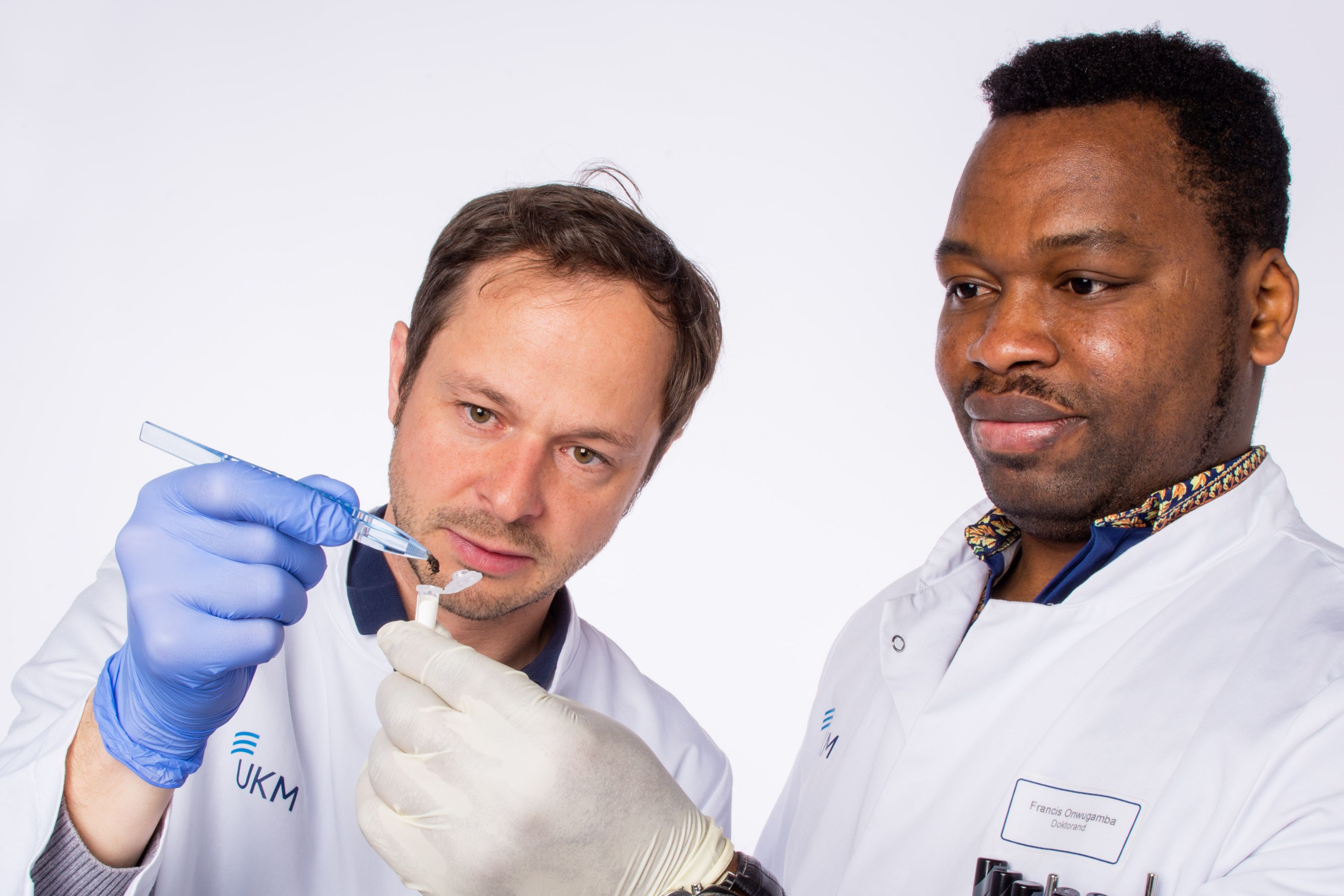News
Das aktuelle "Paper of the Month" (03/2018) geht an: Dr. Silke Niemann vom Institut für Medizinische Mikrobiologie
Für den Monat März 2018 geht das "Paper of the Month" der Medizinischen Fakultät der WWU Münster an:
Dr. Silke Niemann aus dem Institut für Medizinische Mikrobiologie für die Publikation:
Panton-Valentine Leukocidin associated with S. aureus osteomyelitis activates platelets via neutrophil secretion products
By: Niemann, Silke; Bertling, Anne; Brodde, Martin F.; et al.
SCIENTIFIC REPORTS Volume: 8 Article Number: 2185 Published: FEB 01 2018
Zu Hintergrund, Fragestellung und Bedeutung der Publikation:
Einige Staphylococcus aureus Stämme produzieren das Toxin Panton-Valentine Leukocidin (PVL). Die fortschreitende Globalisierung fördert ihre Verbreitung. PVL wird u.a. mit thrombotischen Komplikationen bei Kindern, die unter einer Osteomyelitis leiden, in Zusammenhang gebracht. Bei einer Thrombose spielt die Plättchenaktiverung eine ganz bedeutende Rolle. Aber die Mechanismen, über die PVL die Thrombosenentstehung fördert, sind noch unbekannt. Wir konnten zeigen, dass PVL keinen direkten Einfluss auf die Blutplättchen hat, aber den Zelltod in Granulozyten (PMN) induziert. Dabei werden Abwehrwaffen wie die Defensine, hypochlorige Säure (HOCl), und HOCl-modifizierte Proteine freigesetzt, die dann die Plättchen aktivieren. Das kann dann zur Thrombose führen. Vermutlich ist dieser Mechanismus auch auf andere Toxine, die PMN angreifen, übertragbar. Die Schädigung der PMN durch PVL konnte durch anti-PVL-Antikörper blockiert werden. Dies erklärt, warum Patienten mit geringem Antikörper-Titer ein erhöhtes Risiko für Thrombosen haben. Defensin-Inhibitoren, Glutathion und Resveratrol, welche die Plättchenaktivierung durch HOCl-modifizierte Proteine hemmen, konnten die Plättchenaktivierung in Gegenwart von PVL-geschädigten PMN verhindern. Wir konnten einen Zusammenhang zwischen Thromboseentstehung und PVL aufzeigen und haben einen neuen Mechanismus beschrieben, der auch auf andere Toxine übertragbar ist. Unsere Beobachtungen geben Denkanstöße für neue Ansätze zur Behandlung/ Vorbeugung von thrombotischen Komplikationen in Zusammenhang mit PVL-positiven S. aureus.
Background and fundamental question of the publication:
Panton-Valentine leukocidin (PVL) is a pore-forming toxin produced by some Staphylococcus aureus strains. Globalization promotes the spread of PVL-positive strains. PVL is linked to the development of thrombosis in association with osteomyelitis, especially in children. In thrombosis the activation of platelets plays a key part. However, the mechanisms by which PVL drives thrombosis development are still unknown.
We found that PVL doesn’t have a direct impact on platelets, but induces rapid cell death in neutrophils (PMN), and PMN secretion products, such as defensins, hypochlorous acid (HOCl), and HOCl-modified proteins, are released. These products activate platelets and lead to platelet aggregation, which drives thrombosis. This mechanism might also be transferable to other PMN-targeting toxins. PMN damage by PVL is blocked by anti-PVL-antibodies, explaining why especially young osteomyelitis patients with a presumably low antibody titre against PVL suffer from thrombotic complications. Platelet activation in the presence of PVL-damaged PMNs is prevented by defensin inhibitors and by glutathione and resveratrol, which are both inhibitors of HOCl-modified protein-induced platelet activationWe provide an explanation for the PVL induced thrombosis and describe new mechanism of PVL-neutrophil-platelet interactions, which might be extrapolated to other toxins. Our observations should trigger thoughts about new approaches to treat and/or prevent thrombosis in the course of infections with PVL.
Dr. Silke Niemann aus dem Institut für Medizinische Mikrobiologie für die Publikation:
Panton-Valentine Leukocidin associated with S. aureus osteomyelitis activates platelets via neutrophil secretion products
By: Niemann, Silke; Bertling, Anne; Brodde, Martin F.; et al.
SCIENTIFIC REPORTS Volume: 8 Article Number: 2185 Published: FEB 01 2018
Zu Hintergrund, Fragestellung und Bedeutung der Publikation:
Einige Staphylococcus aureus Stämme produzieren das Toxin Panton-Valentine Leukocidin (PVL). Die fortschreitende Globalisierung fördert ihre Verbreitung. PVL wird u.a. mit thrombotischen Komplikationen bei Kindern, die unter einer Osteomyelitis leiden, in Zusammenhang gebracht. Bei einer Thrombose spielt die Plättchenaktiverung eine ganz bedeutende Rolle. Aber die Mechanismen, über die PVL die Thrombosenentstehung fördert, sind noch unbekannt. Wir konnten zeigen, dass PVL keinen direkten Einfluss auf die Blutplättchen hat, aber den Zelltod in Granulozyten (PMN) induziert. Dabei werden Abwehrwaffen wie die Defensine, hypochlorige Säure (HOCl), und HOCl-modifizierte Proteine freigesetzt, die dann die Plättchen aktivieren. Das kann dann zur Thrombose führen. Vermutlich ist dieser Mechanismus auch auf andere Toxine, die PMN angreifen, übertragbar. Die Schädigung der PMN durch PVL konnte durch anti-PVL-Antikörper blockiert werden. Dies erklärt, warum Patienten mit geringem Antikörper-Titer ein erhöhtes Risiko für Thrombosen haben. Defensin-Inhibitoren, Glutathion und Resveratrol, welche die Plättchenaktivierung durch HOCl-modifizierte Proteine hemmen, konnten die Plättchenaktivierung in Gegenwart von PVL-geschädigten PMN verhindern. Wir konnten einen Zusammenhang zwischen Thromboseentstehung und PVL aufzeigen und haben einen neuen Mechanismus beschrieben, der auch auf andere Toxine übertragbar ist. Unsere Beobachtungen geben Denkanstöße für neue Ansätze zur Behandlung/ Vorbeugung von thrombotischen Komplikationen in Zusammenhang mit PVL-positiven S. aureus.
Background and fundamental question of the publication:
Panton-Valentine leukocidin (PVL) is a pore-forming toxin produced by some Staphylococcus aureus strains. Globalization promotes the spread of PVL-positive strains. PVL is linked to the development of thrombosis in association with osteomyelitis, especially in children. In thrombosis the activation of platelets plays a key part. However, the mechanisms by which PVL drives thrombosis development are still unknown.
We found that PVL doesn’t have a direct impact on platelets, but induces rapid cell death in neutrophils (PMN), and PMN secretion products, such as defensins, hypochlorous acid (HOCl), and HOCl-modified proteins, are released. These products activate platelets and lead to platelet aggregation, which drives thrombosis. This mechanism might also be transferable to other PMN-targeting toxins. PMN damage by PVL is blocked by anti-PVL-antibodies, explaining why especially young osteomyelitis patients with a presumably low antibody titre against PVL suffer from thrombotic complications. Platelet activation in the presence of PVL-damaged PMNs is prevented by defensin inhibitors and by glutathione and resveratrol, which are both inhibitors of HOCl-modified protein-induced platelet activationWe provide an explanation for the PVL induced thrombosis and describe new mechanism of PVL-neutrophil-platelet interactions, which might be extrapolated to other toxins. Our observations should trigger thoughts about new approaches to treat and/or prevent thrombosis in the course of infections with PVL.



